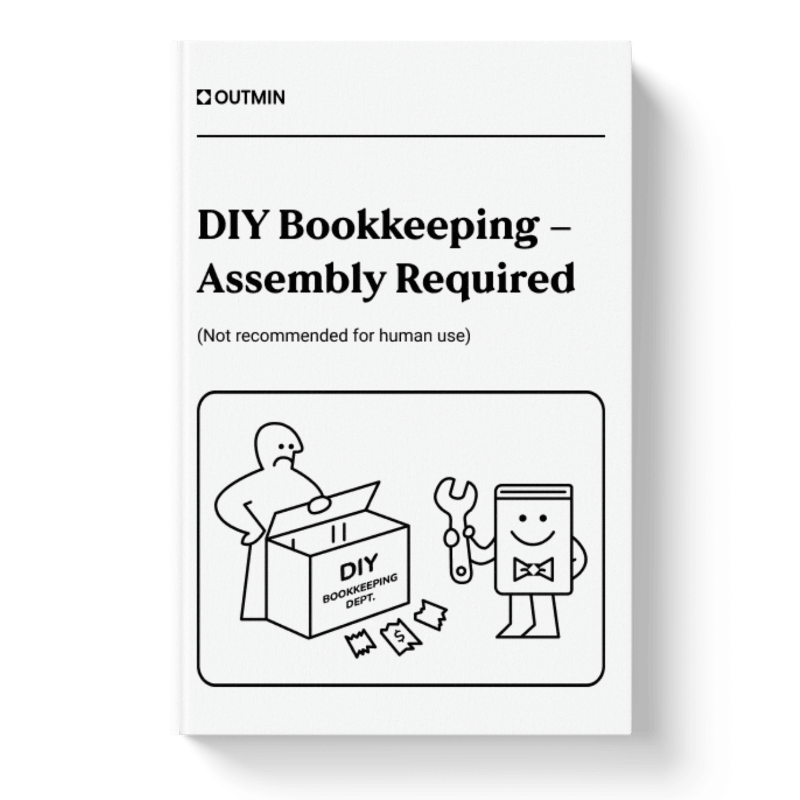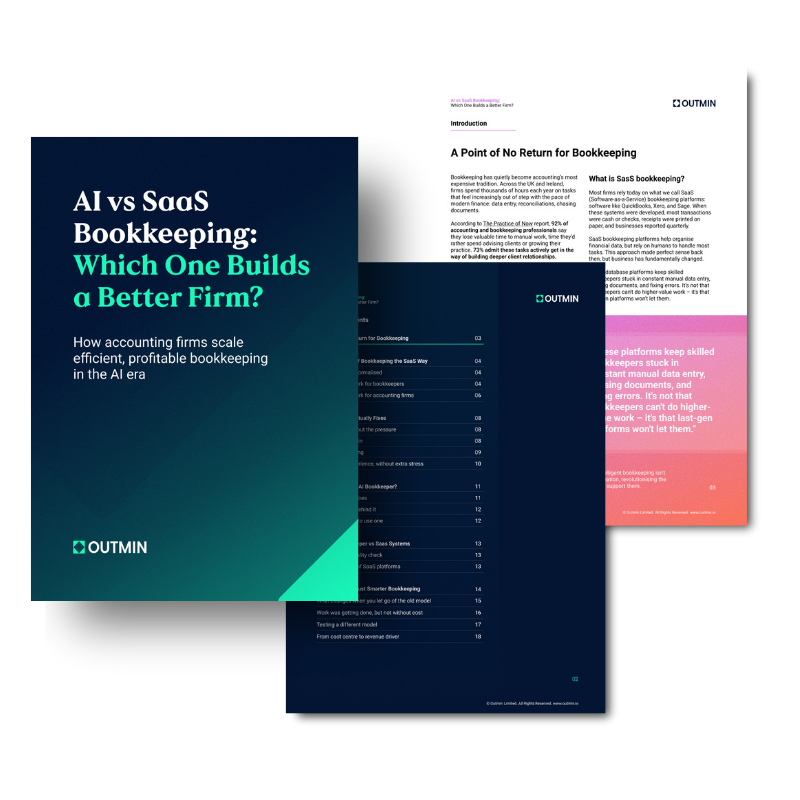July 4, 2025
From Bookkeeping to Advisory: How AI Is Reshaping Accounting Work

The accounting profession is changing faster than ever. CPA.com's new 2025 AI in Accounting Report reveals that artificial intelligence has moved from experiment to essential tool. The shift affects everyone: from solo practitioners to major firms, from bookkeepers to CFOs.
This post breaks down the key themes from the report and shows how Outmin is responding to them. We’ve built a platform that brings these ideas into real workflows, helping both firms and their clients benefit from the shift.
AI is no longer exploratory
Across the firms featured, AI isn’t being treated as a test environment. It’s part of daily operations: in tax workflows, audit prep, reconciliation, and reporting. According to the report:
“Agentic platforms are now completing workflows from start to finish... categorising transactions, flagging anomalies, generating monthly reports, and even drafting client messages.”
These changes are improving not just speed, but also the way firms structure their processes and teams.
Some examples from the report:
- Over 80% automation of individual return prep in some firms
- 50% or more reduction in document analysis time
- Growing use of AI assistants for client communication, triage, and process QA
AI has moved beyond testing phases. It’s now part of the regular operations in many firms, shaping how tasks are handled and delivered.

Time savings, capacity, and efficiency
The outcomes speak for themselves. According t the report, firms that are using AI strategically are seeing:
- Up to 70% less time spent on manual tasks
- Five times faster review cycles
- Two to three times more client capacity without additional hires
Instead of rushing to keep up with admin, teams are focusing on advisory and analysis. And instead of onboarding limits, firms can grow without scaling headcount at the same pace.
This kind of efficiency doesn’t come from using more apps. It comes from reducing the number of moving parts in the system.
Where AI is making the most impact
The report outlines five areas where change is already well under way:
- Bookkeeping and automation AI agents complete entire workflows: transaction categorisation, anomaly detection, monthly reports, even initial client messages.
- Tax preparation and compliance Tasks that once took hours can now be completed in minutes. AI systems extract, populate, and check returns with high accuracy.
- Audit and risk Change here is slower, but firms are beginning to use AI for risk detection and audit prep. It helps professionals focus on high-level review rather than low-level checks.
- Advisory Forecasting, budgeting, and KPI modelling are increasingly powered by AI. This gives firms more to bring to client conversations and makes those conversations more valuable.
- Operational workflows AI assistants are handling admin behind the scenes. Document summarisation, triage, QA bots - they’re improving accuracy and speed without anyone needing to micromanage them.
As Aaron Harris, Sage’s CTO, puts it:
“You’re going to do more, better and differently. This means you’ll be able to take on more client advisory service engagements. On one hand, you’ll have freed up resources to focus on these engagements. On the other hand, AI will enable you to automate some of the tasks associated with them.”
The people side of the shift
What gets automated changes how people are hired and trained. Entry-level jobs are no longer built around task execution. They’re focused on judgment, communication, and understanding how to work with intelligent tools.
Reverse mentoring is helping experienced professionals get familiar with AI-driven workflows. Apprenticeship programs are combining accounting fundamentals with tool fluency. Performance metrics are moving from volume of output to client experience and insight quality.
Avani Desai, CEO of Schellman, captures this clearly:
“The nature of work is changing, and so are our hiring practices. We’re building teams differently and bringing in talent at a variety of levels with a shared focus on critical thinking, adaptability and the ability to partner with AI. It’s not about reducing opportunity, it’s about redefining it.”

Clients are driving change, too
While the report focuses mainly on internal firm transformation, it’s clear that client expectations are accelerating the shift. Businesses want real-time access, fewer delays, and cleaner communication. They expect the same visibility they get in their other platforms.
That means firms can’t keep patching together spreadsheets, inboxes, and off-the-shelf software. The gaps show up in service. The firms that are responding well are the ones replacing fragmented systems with ones that are built to do more (not just track more).
How Outmin puts this into practice
Outmin was built for the world described in this report. We didn’t add AI to existing tools. We built a system from the ground up to handle bookkeeping end-to-end using intelligent automation.
Instead of relying on Xero, Dext, spreadsheets, and inboxes, Outmin replaces the entire bookkeeping stack with one platform that actually does the work.
What it means for accounting firms:
- Automated data collection Outmin connects directly to client bank feeds, sales systems, supplier portals, and email inboxes. The smart bookkeeping system fetches everything needed, continuously.
- Real-time categorisation and reconciliation Transactions are processed as they come in. There’s no need to wait for the end of the month or quarter to clean up the books.
- VAT support built in The system drafts returns automatically, flags outliers for review, and helps your team stay ahead of deadlines.
- Firm-level dashboard You can see the status of every client at a glance. What’s complete, what’s in progress, what needs a response.
- Automatic client prompts Clients are notified when something is missing. You don’t have to chase or explain where to upload a file.
- Faster onboarding Adding new clients is simple and fast. No multi-week setup or system patching.
What it means for your clients:
- Live visibility Clients can check their numbers any time. They no longer have to wait for reports or request updates.
- Simple document upload No more email threads or Dropbox links. They use the platform directly.
- Cleaner communication Outmin shows what’s been received and what’s still needed, reducing confusion and delays.
- One source of truth No conflicting files, versions, or missing receipts. Everyone is on the same page.
By automating the bookkeeping workflow from start to finish, Outmin gives firms the ability to take on more work without sacrificing accuracy, margin, or peace of mind.
Why systems matter more than features
A lot of firms are testing AI right now. But many are doing it through plug-ins or add-ons that don’t address the bigger problem: the workflow itself.
The CPA.com report makes it clear that real value comes when firms update the entire approach, not just bolt new software onto old processes. If you’re still relying on tools that need constant input and correction, you won’t see the same outcomes as firms that have shifted to platforms where the work is done for you.
That’s what Outmin is designed to offer: a bookkeeping system that actually does the work, so your team doesn’t have to.
Get in touch to see how we can help you.









